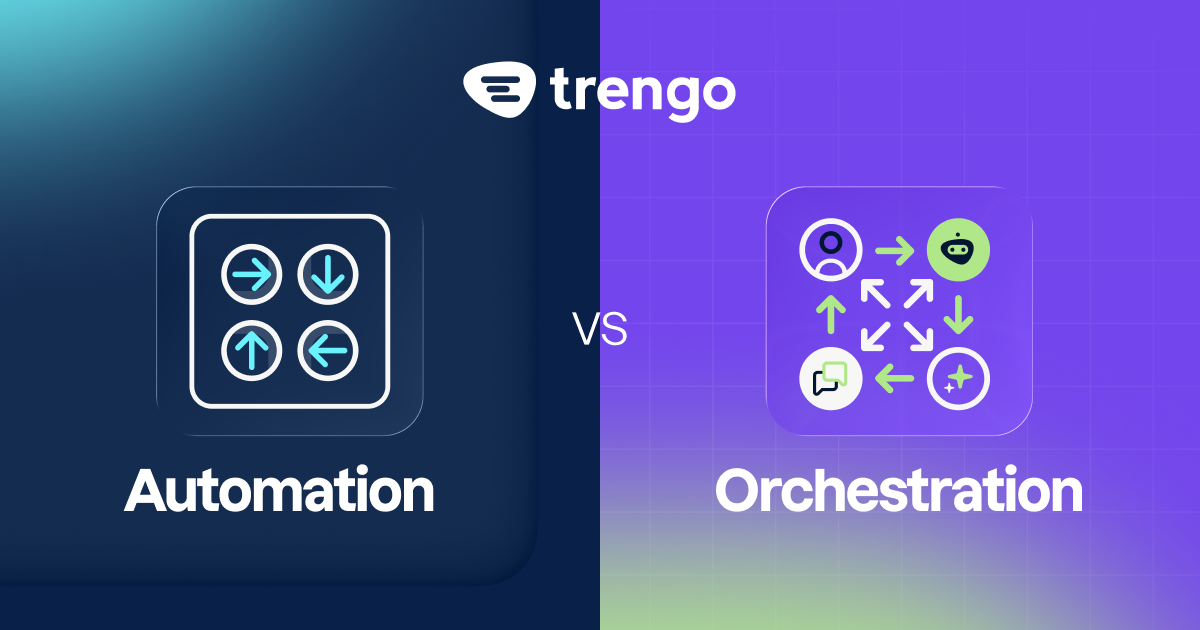Have you ever wished your customer support team could respond faster, without compromising the personal touch? AI agents make that possible. AI customer support is changing the game in customer service by delivering rapid, personalised responses to customers while keeping things efficient and stress-free.
This is a plus for your customer service team as well as your customers. An Intercom report found that 61% of new customers would rather get quick answers from AI agents than wait for a human agent to help them.
If you're wondering how to create AI agents for your business, you’re in the right place. This guide will walk you through what AI agents are, how they work, and the steps to build them. Spoiler: it’s not as complicated as it sounds.
What are AI agents?
AI agents are autonomous systems designed to act independently to accomplish specific goals. They’re powered by advanced algorithms that enable them to perceive their environment, process data, and make decisions, without the need for human intervention.
Unlike traditional programs that follow specific and inflexible instructions, AI agents can learn from experience and adjust their actions based on what they have learned. They use context awareness to understand their surroundings and refine their performance by interacting with data, their environment, and even human feedback.
Types of AI agents
AI agents come in many forms and are designed for different types of interactions. Here’s some of the most common types:
Simple reflex agents
These agents follow straightforward rules to react to specific inputs. For example, a virtual assistant that automatically sends a friendly "Thank you for your order." message right after a customer makes a purchase. This type of system operates based on simple predefined rules.
Model-based reflex agents
More advanced than simple reflex agents, these use an internal model of their environment. This allows them to consider past and present data before deciding on an action.
For example, a customer service bot that tracks previous conversations and current queries to choose the most relevant response is a model-based reflex agent. It doesn’t just react instantly; it considers past interactions to provide a more accurate and helpful answer.
Goal-based agents
These agents go beyond reactions, they aim for specific outcomes. For example, a customer support AI might prioritize resolving issues within the shortest time to improve customer satisfaction.
Utility-based agents
Utility-based agents evaluate different actions based on how beneficial they are. For example, an AI recommending products might weigh user preferences and availability to suggest the best options.
Learning agents
These are the most dynamic types of AI agents. Learning agents evolve by analysing data and feedback, continually refining their capabilities. Spam filters that improve with every flagged email are a great example.
Why AI agents are important?
Customers expect quick, accurate, and personalised responses. AI agents are now enabling businesses to meet these expectations without breaking the bank. Here’s why they matter.
24/7 availability
AI agents are always on, ensuring customers get assistance anytime, whether it’s during peak hours or in the middle of the night.
Scalability
They handle multiple interactions simultaneously, decreasing the chances of delays during peak periods.
Cost savings
By automating repetitive tasks, AI agents reduce the need for extra staff, cutting operational costs without compromising service quality.
Continuous improvement
AI agents learn from data and customer interactions, meaning they get smarter and more effective over time.
Enhanced productivity
AI agents free up human agents to focus on complex or high-value tasks. In fact, support teams have noted that they save time in key areas such as:
- Analyzing customer feedback: 35%
- Suggesting answers from knowledge base content: 34%
- Expanding notes or bullet points into full answers: 28%
- Summarizing customer conversations: 25%
Understanding how to build AI agents tailored to your business needs can help you take advantage of all of these benefits. From guiding customers to resolving issues faster, AI agents empower your teams to deliver exceptional service at scale.
How do AI agents work?
AI agents might sound like something complex, but at their core, they’re designed to learn, adapt, and take action, to make life easier for your team and customers. They combine smart algorithms with data processing to understand their environment, pick up on patterns, and achieve specific goals.
Here’s how it all comes together:
Training on data
AI agents start their journey by learning from data. You can give a customer support AI with your past conversations, FAQs, and product details. It then uses this information to understand how your business communicates and what customers typically need. The better the data, the smarter the AI agent becomes.
Finding data patterns
Once trained, AI agents are pros at spotting patterns. Whether it’s recognizing recurring questions, figuring out customer sentiment, or analyzing behaviour, they identify patterns that help them respond more accurately and efficiently.
Performing actions and goals
After understanding the data, AI agents start to take action. Whether it’s replying to a question, offering personalized product recommendations, or escalating a complex issue to the right team member, they’re focused on achieving the goals you’ve set.
This streamlined process shows why learning how to build AI agents tailored to your needs can transform your customer engagement strategy.
How to build an AI agent in 7 easy steps
Building an AI agent might sound like a daunting task, but breaking it into clear, steps can simplify the process. Each phase helps make your agent a tool tailored to your business needs. Here are seven key steps to learning how to build an AI agent successfully.
Step 1: Define the task and environment
Start by identifying the tasks your AI agent will handle and where it will operate. Will it answer FAQs on your website, assist with orders in your app, or manage live chat support? By clearly defining its purpose and environment, you ensure the agent aligns with your business goals and integrates with existing systems.
Step 2: Gather the right team
Assembling a skilled team is essential. Typically, you’ll need people in roles like:
- machine learning engineers
- data scientists
- software developers
- UX designers
Whether in-house or outsourced, ensure your team has the expertise to gather data, develop algorithms, and build an easy to use interface.
Step 3: Collect and prepare data
Data is the key to any successful AI agent. Gather relevant data such as chat logs, customer feedback, and FAQs will all help your agent give the best responses possible. Preprocessing this data (removing errors, standardizing formats, etc.) is also an essential step for ensuing a well-trained agent.
Step 4: Choose the right tech stack
Your tech stack should fit your goals. For example, use machine learning libraries like TensorFlow or tools like Natural Language Processing (NLP) for chatbots. If you are thinking about scalability, remember that cloud platforms are ideal for businesses that anticipate growth or have seasons with fluctuating demands.
Step 5: Design the AI agent
Collaborate with your team to plan the agent’s structure and user experience. Think about how your AI agent will function and interact with users. A modular design can keep things flexible, making it easy to update or improve specific parts later.
If your agent needs to handle multiple tasks at once, a design that supports multitasking might be better. Don’t forget to make the interface user-friendly with clear buttons, simple navigation, and features like text-to-speech or feedback options. These can make a big difference in how people experience your agent.
Step 6: Test thoroughly
Testing ensures your agent is working well. Perform:
- unit tests on individual modules
- integration tests to check compatibility,
- usability tests with real users
Don’t skip edge-case testing to understand how your agent handles unexpected inputs.
Step 7: Deploy and monitor
Finally, launch your AI agent. Set up monitoring to track metrics like accuracy and response time. Regularly review user feedback to make adjustments, ensuring your agent continues to evolve and meet user needs effectively.
Difference between an AI agent and an AI chatbot?
At first glance, AI agents and chatbots might seem like the same thing as they both handle customer interactions. But when you really look at what they do, you’ll find they’re built for very different purposes.
Chatbots are designed to follow a script or set of predefined rules. They’re great for answering simple, repetitive questions like “What are your business hours?” or “Where’s my order?” But when the conversation goes beyond their programming, they might hit a wall.
AI agents, on the other hand, are far more advanced. They use machine learning to analyze data, adapt to new information, and make decisions independently. Unlike chatbots, AI agents don’t just answer questions, they can:
- understand context
- learn from interactions,
- handle complex tasks like providing personalized recommendations
- route issues to the right department
While chatbots are useful for straightforward queries, AI agents offer a more complex functionality, making them invaluable for businesses looking to deliver smart, efficient, and tailored customer experiences.
AI agents examples & use cases
Here are some real-world examples and use cases to show how businesses create AI agents to solve some of the challenges your business faces.
Multilingual lead generation at BAS World
BAS World, Europe’s largest truck and trailer dealer, needed a way to handle international inquiries across 13 languages, even outside office hours. With AI agents powered by Trengo’s flowbot, BAS World automated tasks like scheduling appointments, sending quotes, and providing product details.
This solution ensures website visitors get a personalized experience in their language, whether it’s English, Dutch, Spanish, or Arabic. The result? A 70% increase in lead generation and a 10% boost in team efficiency, all while saving time for both staff and customers.
AI agents in e-commerce
Online retailers can use AI agents to recommend products based on customer browsing history, preferences, and purchase behavior. These agents deliver personalised shopping experiences, increasing conversion rates and customer loyalty.
Customer support in financial services
Banks and fintech companies deploy AI agents to answer frequently asked questions, guide users through application processes, and even detect potential fraud by analysing transaction patterns.
Healthcare assistance
In healthcare, AI agents help manage patient records, schedule appointments, and answer health-related queries, offering faster support and streamlining operations.
Get started with AI agents
Whether you want to automate lead generation, provide personalized support, or improve team efficiency, learning how to create AI agents tailored to your needs is the first step.
With the right strategy, tools, and data, you can build AI agents that transform the way you engage with customers, freeing up your team to focus on high-value tasks. The best part? AI agents grow smarter over time, continuously adapting to better serve your business and customers.




.png)











